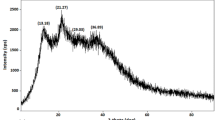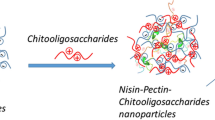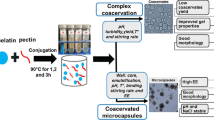Abstract
The aim of this study was to modify pectin by covalent attachment of the water-insoluble ligand 4-aminothiophenol to its polymeric backbone. 4-Aminothiophenol is a ligand which is highly prone to oxidation. Therefore, this ligand allows oxidative cross-linking of pectin under mild oxidative conditions. Additionally, hydrophobization of pectin can be achieved by the mentioned modification which offers certain advantages over highly hydrophilic native pectins. 4-Aminothiophenol was covalently attached to pectin via amide bond formation between carboxylic moieties of pectin and the amino-group of 4-aminothiophenol. Two different pectin–4-aminothiophenol conjugates were synthesized and investigated regarding the amount of coupled ligand, rheological behavior under oxidative conditions, swelling behavior, and cytotoxic effects. Within this study, 557.3 ± 49.0 and 158.8 ± 23.1 μmol 4-aminothiophenol have been coupled per gram pectin. Within both conjugates, around 75% of the bound ligand appeared in its reduced form. Within rheological studies, a 500-fold increase in viscosity was achieved by addition of hydrogen peroxide as an oxidizing agent. Investigations on the swelling behavior revealed that this hydrophobic modification of pectin results in decelerated water uptake on the one hand and improved cohesive properties after oxidation of thiol groups to disulfide bonds on the other hand. Thereby, the maximum amount of water which can be uptaken by pectin matrices could be increased. According to these results, Pec-ATP conjugates could be valuable tools for several pharmaceutical applications due to the established method of gelation and the altered swelling and disintegration behavior.





Similar content being viewed by others

References
May CD. Industrial pectins: sources, production and applications. Carbohydr Polym. 1990;12:79–99.
Thibault JF, Renard CMGC, Axelos MAV, Roger P, Crépau MJ. Studies of the length of homogalacturonic regions in pectins by acid hydrolysis. Carbohydr Res. 1993;238:287–339.
Ralet MC, Dronnet V, Buchholt HC, Thibault JF. Enzymatically and chemically de-esterified lime pectins: characterization, polyelectrolyte behavior and calcium binding properties. Carbohydr Res. 2001;336:117–25.
Endress HU. Nonfood uses of pectin. In: Walter RH, Taylor S, editors. The chemistry and technology of pectin. USA: Academic; 1991. p. 251–68.
Kohn K. Ion binding on polyuronates—alginate and pectin. Pure Appl Chem. 1975;42:371–97.
Oosterveld A, Beldman G, Voragen AGJ. Oxidative cross-linking of pectic polysaccharides from sugar beet pulp. Carbohydr Res. 2000;328:199–207.
Guilherme RG, Moia TA, Reis AV, Paulino AT, Rubira AF, Mattoso LHC, et al. Synthesis and water absorption transport mechanism of a pH-sensitive polymer network structured on vinyl-functionalized pectin. Biomacromolecules. 2009;10:190–6.
Kast CE, Bernkop-Schnürch A. Thiolated polymers—thiomers: development and in vitro evaluation of chitosan–thioglycolic acid conjugates. Biomaterials. 2001;22:2345–52.
Marschütz MK, Bernkop-Schnürch A. Thiolated polymers: self-crosslinking properties of thiolated 450 kDa poly(acrylic acid) and their influence on mucoadhesion. Eur J Pharm Sci. 2002;15:387–94.
Bernkop-Schnürch A, Kast CE, Richter MF. Improvement in the mucoadhesive properties of alginate by the covalent attachment of cysteine. J Control Release. 2001;71:277–85.
Majzoob S, Atyabi F, Dorkoosh F, Kafedjiiski K, Loretz B, Bernkop-Schnürch A. Pectin–cysteine conjugate: synthesis and in vitro evaluation of its potential for drug delivery. J Pharm Pharmacol. 2006;58:1601–10.
Burner U, Jantschko W, Obinger C. Kinetics of oxidation of aliphatic and aromatic thiols by myeloperoxidase compounds I and II. FEBS Lett. 1999;443:290–6.
Silioc C, Maleki A, Zhu K, Kjoniksen AL, Nystrom B. Effect of hydrophobic modification on rheological and swelling features during chemical gelation of aqueous polysaccharides. Biomacromolecules. 2007;8:710–28.
Mortazavi SA, Smart SD. An investigation into the role of water movement and mucus gel dehydration in mucoadhesion. J Control Rel. 1993;25(3):197–203.
Bernkop-Schnürch A, Schwarz V, Steininger S. Polymers with thiol groups: a new generation of mucoadhesive polymers? Pharm Res. 1999;16:876–81.
Habeeb AF. A sensitive method for localization of disulfide containing peptides in column effluents. Anal Biochem. 1973;56:60–5.
Satake K, Okuyama T, Ohashi M, Shinoda T. The spectrophotometric determination of amines, amino acids and peptide with 2, 4, 6-trinitrobenzene-1-sulfonic acid. J Biochem. 1960;47:654.
Niles AL, Moravec RA, Hesselberth PE, Scurria MA, Daily WJ, Riss TL. A homogenous assay to measure live and dead cells in the same sample by detecting different protease markers. Anal Biochem. 2007;366:197–206.
Bernkop-Schnürch A, Hornof M, Zoidl T. Thiolated polymers—thiomers: synthesis and in vitro evaluation of chitosan-2-iminothiolane conjugates. Int J Pharm. 2003;260:229–37.
Sakloetsakun D, Hombach J, Bernkop-Schnürch A. In situ gelling properties of chitosan–thioglycolic acid conjugate in the presence of oxidizing agents. Biomaterials. 2009;30:6151–7.
Semdé R, Moes AJ, Devleeschouwer MJ, Amighi K. Synthesis and enzymatic degradation of epichlorohydrin cross-linked pectins. Drug Dev Ind Pharm. 2003;29:203–13.
Verma RP, Kapur S, Barberena O, Shusterman A, Hansch CH, Selassie CD. Synthesis, cytotoxicity and QSAR analysis of X-thiophenols in rapidly dividing cells. Chem Res Toxicol. 2003;16:276–84.
O’Brien AB, Philp K, Morris ER. Gelation of high-methoxy pectin by enzymatic de-esterification in the presence of calcium ions: a preliminary evaluation. Carbohydr Res. 2009;344:1818–23.
Rosenbohm C, Lundt I, Christensen TMIE, Young NWG. Chemically methylated and reduced pectins: preparation, characterisation by 1H NMR spectroscopy, enzymatic degradation, and gelling properties. Carbohydr Res. 2003;338:637–49.
Sriamornsak P, Kennedy RA. Swelling and diffusion studies of calcium polysaccharide gels intended for film coating. Int J Pharm. 2008;358:205–13.
Krauland AH, Bernkop-Schnürch A. Thiomers: development and in vitro evaluation of a peroral microparticulate peptide delivery system. Eur J Pharm Biopharm. 2004;57:181–7.
Author information
Authors and Affiliations
Corresponding author
Rights and permissions
About this article
Cite this article
Perera, G., Hombach, J. & Bernkop-Schnürch, A. Hydrophobic Thiolation of Pectin with 4-Aminothiophenol: Synthesis and In Vitro Characterization. AAPS PharmSciTech 11, 174–180 (2010). https://doi.org/10.1208/s12249-009-9370-7
Received:
Accepted:
Published:
Issue Date:
DOI: https://doi.org/10.1208/s12249-009-9370-7



